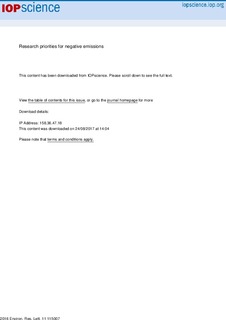| dc.contributor.author | Fuss, Sabine | |
| dc.contributor.author | Jones, Chris D. | |
| dc.contributor.author | Kraxner, Florian | |
| dc.contributor.author | Peters, Glen Philip | |
| dc.contributor.author | Smith, Pete | |
| dc.contributor.author | Tavoni, Massimo | |
| dc.contributor.author | van Vuuren, Detlef Peter | |
| dc.contributor.author | Canadell, Josep G. | |
| dc.contributor.author | Jackson, Robert B. | |
| dc.contributor.author | Milne, Jennifer L. | |
| dc.contributor.author | Moreira, José Roberto | |
| dc.contributor.author | Nakicenovic, Nebojsa | |
| dc.contributor.author | Sharifi, Ayyoob | |
| dc.contributor.author | Yamagata, Yoshiki | |
| dc.date.accessioned | 2017-11-09T14:21:14Z | |
| dc.date.available | 2017-11-09T14:21:14Z | |
| dc.date.created | 2016-11-30T22:01:29Z | |
| dc.date.issued | 2016 | |
| dc.identifier.issn | 1748-9326 | |
| dc.identifier.uri | http://hdl.handle.net/11250/2465353 | |
| dc.description.abstract | Carbon dioxide removal from the atmosphere (CDR)—also known as 'negative emissions'—features prominently in most 2 °C scenarios and has been under increased scrutiny by scientists, citizens, and policymakers. Critics argue that 'negative emission technologies' (NETs) are insufficiently mature to rely on them for climate stabilization. Some even argue that 2 °C is no longer feasible or might have unacceptable social and environmental costs. Nonetheless, the Paris Agreement endorsed an aspirational goal of limiting global warming to even lower levels, arguing that climate impacts—especially for vulnerable nations such as small island states—will be unacceptably severe in a 2 °C world. While there are few pathways to 2 °C that do not rely on negative emissions, 1.5 °C scenarios are barely conceivable without them. Building on previous assessments of NETs, we identify some urgent research needs to provide a more complete picture for reaching ambitious climate targets, and the role that NETs can play in reaching them. | |
| dc.language.iso | eng | |
| dc.title | Research priorities for negative emissions | |
| dc.type | Peer reviewed | |
| dc.type | Journal article | |
| dc.description.version | publishedVersion | |
| dc.source.volume | 11 | |
| dc.source.journal | Environmental Research Letters | |
| dc.source.issue | 11 | |
| dc.identifier.doi | 10.1088/1748-9326/11/11/115007 | |
| dc.identifier.cristin | 1406824 | |
| dc.relation.project | Norges forskningsråd: 259665 | |
| dc.relation.project | Norges forskningsråd: 209701 | |
| cristin.unitcode | 7475,0,0,0 | |
| cristin.unitname | CICERO Senter for klimaforskning | |
| cristin.ispublished | true | |
| cristin.fulltext | original | |
| cristin.qualitycode | 1 | |
